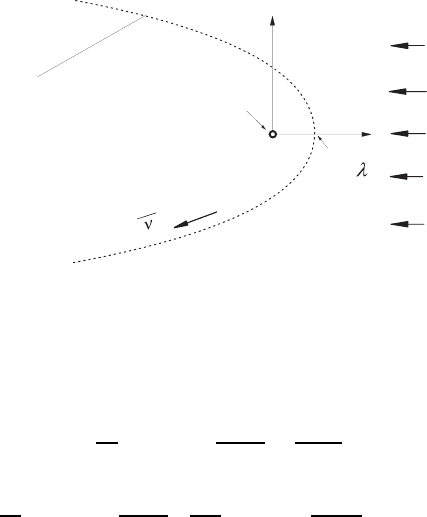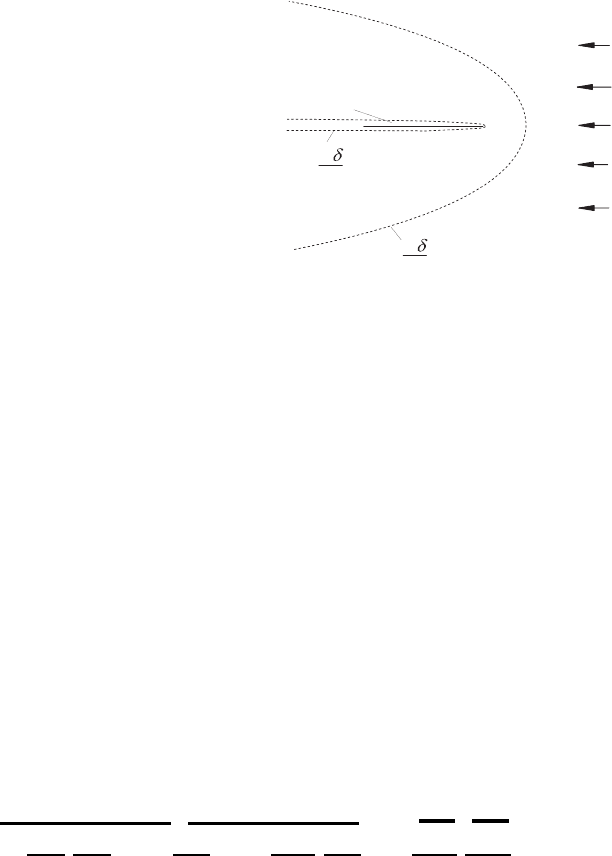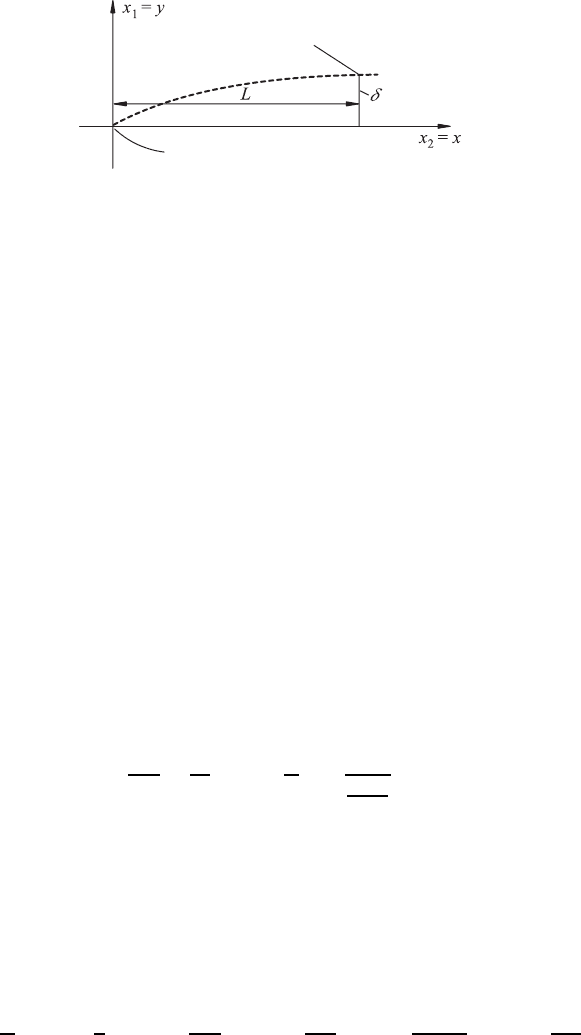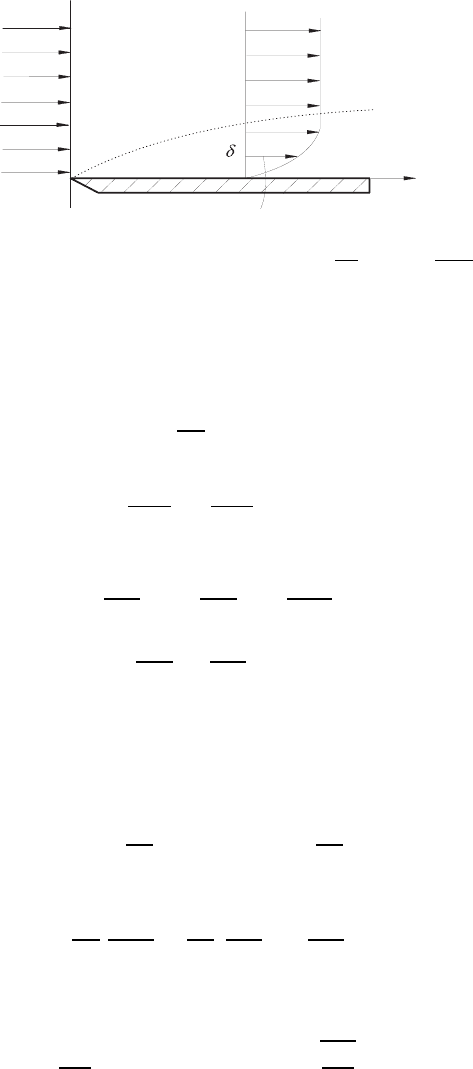Durst F. Fluid Mechanics: An Introduction to the Theory of Fluid Flows
Подождите немного. Документ загружается.


References 461
U d
of order 1
Undisturbed
oncoming flow
Boundary of region with
velocity and temperature
influence
Cylinder
.
x
1
(
)
x
2
x
1
Fig. 15.14 Finite area for the dissipation of heat or rotational momentum for small
Reynolds numbers
cylinder the area in which inflow conditions have to be imposed that are not
disturbed by the cylinder. According to (15.193), one obtains
x
1
D
µ
> const
ν
U
∞
D
=
const
Re
(15.194)
or
x
1
D
λ
> const
ν
U
∞
D
λ
µc
v
=const
1
RePr
. (15.195)
Equation (15.194) shows that with decreasing Reynolds number the inte-
gration area increases, which has to be covered with a numerical grid when
numerical integration procedures are employed, in order to install the bound-
ary conditions holding at infinity. An additional extension of the computation
area results for Peclet numbers, Pe=(ReP r) < 1, i.e. for Pr < 1, when the
temperature field of a flow around a cylinder also has to be computed.
References
15.1. F.S. Sherman: “Viscous Flow” McGraw Hill, New York, 1990
15.2. S.W. Yuan: “Foundations of Fluid Mechanics”, Civil Engineering and
Mechanics Series, Mei Ya, Taipei, Taiwan (1971)
15.3. H. Lamb: “On the Uniform Motion of a Sphere Through a Viscous Fluid”, Phil.
Mag. 21, p. 120 (1911)
15.4. H. Lamb: “Hydrodynamics”, Dover, New York, 1945
15.5. H. Schlichting: “Boundary Layer Theory”, 6th Edition, McGraw Hill, New York
(1968)
15.6. R.B. Bird, W.E. Stewart, E.N. Lightfoot: “Transport Phenomena”, Wiley, New
York (1960)
15.7. C.S. Yih: “Fluid Mechanics - A Concise Introduction to the Theory”, West
River, Ann Arbor, MI, 1979
15.8. M. van Dyke: “The Album of Fluid Motion”, The Parabolic Press, Stanford,
California, 1982

Chapter 16
Flows of Large Reynolds Numbers
Boundary-Layer Flows
16.1 General Considerations and Derivations
In Chap. 15, flows that were characterized by small Reynolds numbers (Re)
were considered, i.e. fluid flows were treated that were diffusion-dominated
and where convection played a secondary role. This can be expressed by small
Re,e.g.whentakingRe as a ratio of forces:
Re =
U
c
L
c
ν
c
=
ρ
c
U
2
c
µ
c
U
c
L
c
=
acceleration forces
viscosity forces
, (16.1)
where ρ
c
and µ
c
represent the density and viscosity characterizing a fluid,
respectively, U
c
represents a characteristic velocity and L
c
is a length
characterizing the flow domain.
Equivalent considerations on the significance of Re can, however, also be
expressed by the ratio of times typical for diffusion and convection processes
in the considered fluid flows:
Re =
U
c
L
c
ν
c
=
L
2
c
/ν
c
L
c
/U
c
=
diffusion times
convection times
(16.2)
or by the corresponding velocities that are typical for diffusion and convection
processes:
Re =
U
c
L
c
ν
c
=
U
c
ν
c
/L
c
=
convection velocities
diffusion velocities
. (16.3)
Considering flows of large Re, i.e. flows in which the acceleration forces are
large in comparison with the viscous forces, or in which the diffusion times
are large in comparison with the convection times, or the convection velocities
are large in comparison with the diffusion velocities, it can be shown that,
e.g., the influences of wall boundaries on flows are limited to small areas near
the walls. This is sketched in Fig. 16.1, which shows the flow around a flat
plate and indicates there the small region near the wall, where viscous influ-
ences can be observed. The contents of this figure results from the extended
463

464 16 Flows of Large Reynolds Numbers
Fig. 16.1 Area limitations for diffu-
sion processes with Re ≈ 1andin
the case of a flow around a plate for
Re 1
Undisturbed
flow
U
ν
>>
1
U
~
~
1
Wall near region for
high
Re
-numbers
ν
considerations which were carried out at the end of Chap. 15. Applying the
insights gained from Sect. 15.9 to the flow around a flat plate, a large region
results for Re ≈ 1, in which diffusion processes are present. In this region,
information about the presence of the plate (around which the flow passes)
is available. When, on the other hand, conditions exist that are character-
ized by Re 1, the influence of the diffusion remains restricted to a small
region very close to the plate. There, a so-called wall boundary layer forms.
Boundary layers of this kind are thus the characteristic properties of flows
of high Re. Such flows can therefore be subdivided into body-near regions,
where viscous influences on flows have to be considered, and regions that
are distant from the wall, which can be regarded as being free from viscous
influences.
The above considerations show clearly that special treatments are neces-
sary, in order to derive the equations that can be employed as approximations
of the Navier–Stokes equations for Re 1 to solve flow problems. Looking
for derivations where the viscous terms, because Re 1, are completely ne-
glected in the differential equations describing the flow results in the Euler
equations:
standardized Euler equation
ρ
∗
L
c
t
c
U
c
∂U
∗
j
∂t
∗
+ U
∗
i
∂U
∗
j
∂x
∗
i
= −
∆P
c
ρ
c
U
2
c
∂P
∗
∂x
∗
j
+
⇒0 because Re⇒∞
ν
c
U
c
L
c
∂
2
U
∗
j
∂x
∗
i
2
. (16.4)
These equations are not applicable to solving wall boundary-layer flow prob-
lems. For the derivation of the boundary-layer equations, one has rather to
apply considerations as proposed by Prandtl (1904, 1905). They are based on
order of magnitude considerations of the terms in the Navier–Stokes equa-
tions, taking into consideration the differences in the times and velocities
in diffusion and convection transport processes. If one neglects the viscous
terms entirely, this would be equivalent to a reduction of the order of the

16.1 General Considerations and Derivations 465
Point at edge
of boundary layer
Start of flat plate
x
1
= x where x = the boundary-layer coordinate in the flow direction
x
2
= y where y = the boundary-layer coordinate vertical to the flow direction
Fig. 16.2 Boundary-layer thickness along a plane flat plate and its development
basic equations describing the fluid flow. Hence it would not be possible to
implement all the boundary conditions characterizing a flow, and flows that
result in this way from the differential equations as solutions would show
considerable deficits.
The transition from the generally valid Navier–Strokes equations to the
boundary-layer equations, as indicated in Fig. 16.1, is an essential step which
has to be taken into consideration, in order to admit only such simplifications
of the Navier–Stokes equations which result in physically still reasonable
solutions. The resultant equations are called the boundary-layer equations.
When choosing L as a distance in the flow direction along the flat plate flow
indicated in Fig. 16.2, δ is the resultant boundary-layer thickness, Fig. 16.1
showing that δ L holds for large Re. Considering the times:
∆t
c
= L/U
∞
convection time,
∆t
D
= δ
2
/ν diffusion time
one obtains, as ∆t
c
= ∆t
D
for the boundary point δ(L):
L
U
∞
=
δ
2
ν
;
δ
L
=
*
1
U
∞
δ
ν
+
. (16.5)
The boundary-layer thickness δ, normalized with the development length,
is proportional to the reciprocal of the Reynolds number, formed with the ex-
ternal flow velocity and the boundary-layer thickness: (δ/L)=1/Re
δ
.Paying
attention to the context in (16.3), it results for the diffusion velocity occur-
ring in the y-direction that U
D
= U
y
≈ ν/δ, so that for considerations of
the orders of magnitude of the terms in the Navier–Stokes equations, the
following normalization can be carried out:
x
∗
=
x
L
; y
∗
=
y
δ
; U
∗
x
=
U
x
U
∞
; U
∗
y
=
U
y
ν/δ
; t
∗
=
t
L/U
∞
; P
∗
=
P
P
∞
.
(16.6)

466 16 Flows of Large Reynolds Numbers
Introducing these normalized quantities into the two-dimensional Navier–
Stokes equations with constant fluid properties:
∂U
1
∂x
1
+
∂U
2
∂x
2
=0, (16.7)
ρ
∂U
1
∂t
+ U
1
∂U
1
∂x
1
+ U
2
∂U
1
∂x
2
= −
∂P
∂x
1
+ µ
∂
2
U
1
∂x
1
2
+
∂
2
U
1
∂x
2
2
, (16.8)
ρ
∂U
2
∂t
+ U
1
∂U
2
∂x
1
+ U
2
∂U
2
∂x
2
= −
∂P
∂x
2
+ µ
∂
2
U
2
∂x
1
2
+
∂
2
U
2
∂x
2
2
(16.9)
the below-stated derivations can be carried out and for the continuity
equation one obtains:
U
∞
L
∂U
∗
x
∂x
∗
+
ν
δ
2
∂U
∗
y
∂y
∗
=0 ;
∂U
∗
x
∂x
∗
+
νL
U
∞
δ
2
≈1
∂U
∗
y
∂y
∗
=0, (16.10)
where the term νL/U
∞
δ
2
=(L/U
∞
)/(δ
2
/ν) is the relationship for the ratio
of the convection and diffusion times. According to (16.5), both terms are
equal, so that both gradients in the continuity equation are of the same order
of magnitude and therefore have to be carried along in the boundary-layer
equations. Thus the continuity equation for boundary-layer flows reads:
∂U
x
∂x
+
∂U
y
∂y
=0. (16.11)
For the momentum equation in the x-direction, the normalization yields:
ρ
U
2
∞
L
∂U
∗
x
∂t
∗
+
U
2
∞
L
U
∗
x
∂U
∗
x
∂x
∗
+
νU
∞
δ
2
U
∗
y
∂U
∗
x
∂y
∗
= −
P
∞
L
∂P
∗
∂x
∗
+ µ
U
∞
L
2
∂
2
U
∗
x
∂x
∗
2
+
U
∞
δ
2
∂
2
U
∗
x
∂y
∗
2
. (16.12)
On dividing the entire equation by ρU
2
∞
/L,oneobtains:
∂U
∗
x
∂t
∗
+ U
∗
x
∂U
∗
x
∂x
∗
+
νL
U
∞
δ
2
≈1
U
∗
y
∂U
∗
x
∂y
∗
= −
P
∞
ρU
2
∞
∂P
∗
∂x
∗
+
ν
U
∞
L
δ/(LRe
δ
)
∂
2
U
∗
x
∂x
∗
2
+
νL
U
∞
δ
2
≈1
∂
2
U
∗
x
∂y
∗
2
. (16.13)
With δ/L ≈ 1/Re
δ
, the first of the two viscous terms in (16.13), multiplied
by 1/Re
2
δ
, can be regarded as negligible for Re
δ
1. Thus for the boundary

16.1 General Considerations and Derivations 467
layer form of the x-momentum equation the following equation holds:
ρ
∂U
x
∂t
+ U
x
∂U
x
∂x
+ U
y
∂U
x
∂y
= −
∂P
∂x
+ µ
∂
2
U
x
∂y
2
. (16.14)
Analogous derivations yield for the two-dimensional y-momentum equation:
ρ
νU
∞
δL
∂U
∗
y
∂t
∗
+
U
∞
ν
δL
U
∗
x
∂U
∗
y
∂x
∗
+
ν
2
δ
3
U
∗
y
∂U
∗
y
∂y
∗
= −
P
∞
δ
∂P
∗
∂y
∗
+ µ
3
ν
δL
2
∂
2
U
∗
y
∂x
∗
2
+
ν
δ
3
∂
2
U
∗
y
∂y
∗
2
4
. (16.15)
On dividing this equation also by ρU
2
∞
/L, the following equation results:
ν
δU
∞
∂U
∗
y
∂t
∗
+
ν
δU
∞
U
∗
x
∂U
∗
y
∂x
∗
+
ν
U
∞
δ
νL
U
∞
δ
2
≈1
U
∗
y
∂U
∗
y
∂y
∗
= −
P
∞
L
ρU
2
∞
δ
∂P
∗
∂y
∗
+
ν
U
∞
δ
ν
U
∞
L
∂
2
U
∗
y
∂x
∗
2
+
ν
U
∞
δ
2
L
δ
∂
2
U
∗
y
∂y
∗
2
(16.16)
or rewritten:
1
Re
δ
∂U
∗
y
∂t
∗
+ U
∗
x
∂U
∗
y
∂x
∗
+ U
∗
y
∂U
∗
y
∂y
∗
= −
P
∞
ρU
2
∞
Re
δ
∂P
∗
∂y
∗
+
3
1
Re
3
δ
∂
2
U
∗
y
∂x
∗
2
+
1
Re
δ
∂
2
U
∗
y
∂y
∗
2
4
. (16.17)
From (16.17), it can be seen that all acceleration and viscous terms can be
neglected when compared with terms in (16.14). Because Re 1, they are
very small in comparison with the corresponding terms in the x-momentum
equation (16.14). Thus the y-momentum equation results in the following
equation:
∂P
∂y
=0. (16.18)
This equation expresses the fact that the pressure in a boundary layer, vertical
to the flow direction, does not change. The boundary layer thus experiences,
up to the wall, the pressure change imposed in the x-direction on the outer
flow. This means for many problem solutions that the pressure distribution
P (x, y)=P
∞
(x) is known, so that, through the boundary-layer equations for
the solution of flow problems, only the velocity components U
x
and U
y
have
to be determined.

468 16 Flows of Large Reynolds Numbers
Looking at the above derivations, the two-dimensional boundary-
layer equations can be stated as follows, on the basis of the above
order-of-magnitude considerations:
∂U
x
∂x
+
∂U
y
∂y
=0, (16.19a)
ρ
∂U
x
∂t
+ U
x
∂U
x
∂x
+ U
y
∂U
x
∂y
= −
∂P
∂x
+ µ
∂
2
U
x
∂y
2
, (16.19b)
∂P
∂y
=0. (16.19c)
Equations (16.19) are, as can easily be shown, a set of parabolic differential
equations. They can be solved with the corresponding boundary conditions
for some flow geometries and thus make it possible to compute the velocity
distributions in boundary-layer flows with simpler equations than the Navier–
Stokes equations. There are numerous text books that describe the above
boundary-layer equations, e.g. see refs [16.4] to [16.9]
16.2 Solutions of the Boundary-Layer Equations
In the preceding section the boundary-layer equations were derived:
∂U
x
∂x
+
∂U
y
∂y
=0, (16.20a)
ρ
∂U
x
∂t
+ U
x
∂U
x
∂x
+ U
y
∂U
x
∂y
= −
∂P
∂x
+ µ
∂
2
U
x
∂y
2
, (16.20b)
∂P
∂y
=0. (16.20c)
For the outer flow, where no viscous effects occur, the pressure distribution
can be determined through the Euler form of the momentum equation:
∂U
∞
∂t
+ U
∞
∂U
∞
∂x
= −
1
ρ
∂P
∂x
. (16.21)
Because of (16.20c), the momentum equation (16.20b) can be written as
follows, taking (16.21) into account:
∂U
x
∂t
+ U
x
∂U
x
∂x
+ U
y
∂U
x
∂y
=
∂U
∞
∂t
+ U
∞
∂U
∞
∂x
+ ν
∂
2
U
x
∂y
2
. (16.22)
It is necessary to solve this equation together with (16.20a), in order to
compute boundary-layer flows. However, the validity of this equation has
strictly been verified only for Cartesian coordinates. It should be pointed
out, however, that it holds also for curved coordinates, when the radius of

16.2 Solutions of the Boundary-Layer Equations 469
curvature of the flow lines is large in comparison with the boundary layer
thickness δ.
In order to solve the boundary layer equation, it is recommended to
introduce the stream function Ψ , so that the continuity equation is eliminated:
U
1
=
∂Ψ
∂x
2
=
∂Ψ
∂y
= U
x
; U
2
= −
∂Ψ
∂x
1
= −
∂Ψ
∂x
= U
y
. (16.23)
Thus, according to (16.22), the following partial differential equation for the
stream function Ψ can be derived:
∂
2
Ψ
∂t∂y
+
∂Ψ
∂y
∂
2
Ψ
∂x∂y
−
∂Ψ
∂x
∂
2
Ψ
∂y
2
=
∂U
∞
∂t
+ U
∞
∂U
∞
∂x
+ ν
∂
3
Ψ
∂y
3
. (16.24)
We therefore have to deal with a partial differential equation of third order,
which has to be solved for the stream function Ψ (x, y, t). Hence the solution
of the equation requires one to state three boundary conditions and suitable
initial conditions. Attention has to be paid to the fact that the different
boundary-layer flows are given by the corresponding boundary and initial
conditions. The transport processes occurring in the boundary-layers are all
described, however, by the differential equation for Ψ.
When stationary flow conditions exist, from (16.24) the following equation
results for
∂
∂t
!
∂Ψ
∂x
"
=0:
∂Ψ
∂y
∂
2
Ψ
∂x∂y
−
∂Ψ
∂x
∂
2
Ψ
∂y
2
= U
∞
dU
∞
dx
+ ν
∂
3
Ψ
∂y
3
. (16.25)
This equation was stated by Blasius (1908) for the case of a flow over a plane
plate with U
∞
= constant and was also solved by him analytically.
For the case of stationary boundary layer flows, von Mises (1927) at-
tributed the boundary-layer equations to a non-linear partial differential
equation of second order, which corresponded to the equation typical for heat
conduction. The essential points of the derivation of the von Mises differential
equation can be summarized as shown below.
The derivations proposed by von Mises start also from the stream func-
tion Ψ , which is, however, introduced into the derivation as an independent
variable, so that the following holds:
U
x
(x, y)=V
x
(x, Ψ)andU
y
(x, y)=V
y
(x, Ψ). (16.26)
With this, the relationships below can be stated:
∂U
x
∂x
=
∂V
x
∂x
+
∂V
x
∂Ψ
∂Ψ
∂x
=
∂V
x
∂x
− U
y
∂V
x
∂Ψ
, (16.27)
∂U
x
∂y
=
∂V
x
∂Ψ
∂Ψ
∂y
= U
x
∂V
x
∂Ψ
= V
x
∂V
x
∂Ψ
. (16.28)

470 16 Flows of Large Reynolds Numbers
For the second derivatives with respect to y, one obtains the following
intermediate result:
∂
2
U
x
∂y
2
=
∂
∂y
∂U
x
∂y
=
∂
∂y
U
x
∂V
x
∂Ψ
= U
2
x
∂V
x
∂Ψ
+ U
x
∂V
x
∂Ψ
2
= U
x
3
U
x
∂V
x
∂Ψ
+
∂V
x
∂Ψ
2
4
= U
x
∂
∂Ψ
V
x
∂V
x
∂Ψ
. (16.29)
Thus the following second derivative can be deduced:
∂
2
U
x
∂y
2
= U
x
∂
∂Ψ
∂
∂Ψ
1
2
V
2
x
= V
x
∂
2
∂Ψ
2
1
2
V
2
x
. (16.30)
On inserting (16.27)–(16.30) into the boundary layer form of the stationary
momentum equation, the following results:
V
x
∂V
x
∂x
= U
∞
dU
∞
dx
+ νV
x
∂
2
∂Ψ
2
V
2
x
2
(16.31)
or rewritten:
∂V
2
x
∂x
=
dU
2
∞
dx
+ νV
x
∂
2
∂Ψ
2
!
V
2
x
"
. (16.32)
If one now introduces a new function:
V(x, Ψ)=U
2
∞
− V
2
x
(16.33)
so that V
x
=
U
2
∞
−V holds, the differential equation (16.32) adopts the
so-called von Mises form:
∂V
∂x
= ν
U
2
∞
−V
∂
2
V
∂Ψ
2
. (16.34)
The von Mises differential equation has to satisfy the boundary conditions:
Ψ =0: U
x
=0, i.e. V = U
2
∞
,
Ψ →∞: U
x
→ U
∞
, i.e. V =0.
(16.35)
The above general solution ansatz for the boundary layer equations are
applied to different flows in subsequent chapters.
16.3 Flat Plate Boundary Layer (Blasius Solution)
The flow over a flat plate, sketched in Fig. 16.3, represents the flow of a fluid
having constant fluid properties and also a constant inflow velocity. This
inflow hits, at the origin of the x–y coordinate system, an infinitely extended

16.3 Flat Plate Boundary Layer (Blasius Solution) 471
U
00
U
00
x
U
( y)
for
x = constant
x
{
Fig. 16.3 Formation of a plate boundary layer with
∂P
∂x
=0and
dU
∞
dx
=0
flat plate, positioned in the x–y coordinate system, so that along the flat plate
a boundary layer flow forms. For the latter the boundary layer equations
(16.20a)–(16.20c) hold, with the simplifications according to (16.21):
∂P
∂x
= 0 (16.36)
and
∂U
∞
∂x
=
dU
∞
dx
= 0 (16.37)
so that the boundary layer equations hold as follows:
U
x
∂U
x
∂x
+ U
y
∂U
x
∂y
= ν
∂
2
U
x
∂y
2
, (16.38)
∂U
x
∂x
+
∂U
y
∂y
= 0 (16.39)
with the boundary conditions:
y =0: U
x
= U
y
=0 and y →∞: U
x
→ U
∞
. (16.40)
On introducing the stream function Ψ for the elimination of the continuity
equation:
U
x
=
∂Ψ
∂y
and U
y
= −
∂Ψ
∂x
(16.41)
one obtains the following differential equation for the x-momentum transport:
∂Ψ
∂y
∂
2
Ψ
∂x∂y
−
∂Ψ
∂x
∂
2
Ψ
∂y
2
= ν
∂
3
Ψ
∂y
3
. (16.42)
Blasius proposed a similarity solution for (16.42), such that the solution was
obtained with the ansatz
U
x
U
∞
= F (η) with η = y
0
U
∞
νx
. (16.43)
